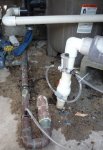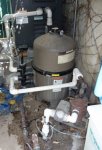Greetings, all. First-time poster, so please forgive my newbie-ness! 
I'll try to condense this story as best I can:
I just joined my condo association's Board of Directors, and assumed responsibility for our outdoor pool. (I started with basically zero knowledge, but through some voracious reading--much of it here--have tried to get up to speed.)
We hired a new pool service, who, in theory, should completely take care of our pool. They recommended a Liquidator, and we had them install one last week. Then the adventure began...
When the installer left, I found the unit wasn't functioning; it wasn't filling with water. I removed the "IN" line check valve, and that cured the problem. (As a result, the tank drains to the level of the input float when the pump shuts off at night.) The unit could initially deliver and maintain a "5" on the flow meter; I set it around 2. The installer had no liquid chlorine, so I bought and added 2 gallons myself.
But after a few days, I saw the flow decreasing to the point where even with the valve wide-open, flow was only about 1.5. The problem seems to be supply pressure; the LQ tank is no longer completely filling up. My guess is that this relates to our filter condition: the LQ was installed just after our Hayward DE filter had been cleaned and was at top efficiency. Now, as the Hayward pressure indicator is nearly in the red, there seems to be insufficient pressure in the pool return line to fill the LQ. (And now, as of this morning, there is no refill at all and zero flow from the LQ.)
So, QUESTION 1: The installer tapped the LQ input fitting into our pool return line after the filter and about 3 feet past the heater. Would tapping the line closer to the filter make any difference in pressure? We would have several options, including about two feet back from the existing tap, a foot-long PVC section between the filter and the heater, or even the heater drain plug (if that's viable.) Could this help?
Then, today's more startling news: When the pool cleaning kid (who I believe is basically just taught "paint by numbers" with no real theory) shows up, he wants to add POWDERED (granulated?) chlorine to the Liquidator. ?!?!?! He says the owner "doesn't give him liquid chlorine." Pardon my ignorance, but what's the point of having a LIQUIDator if you don't use liquid chlorine?
So, QUESTION 2: Before I open a discussion with our pool vendor...is there any earthly reason you would want to run a Liquidator like that? Color me perplexed...
Thanks for any replies, and please let me know if I can provide more info.
I'll try to condense this story as best I can:
I just joined my condo association's Board of Directors, and assumed responsibility for our outdoor pool. (I started with basically zero knowledge, but through some voracious reading--much of it here--have tried to get up to speed.)
We hired a new pool service, who, in theory, should completely take care of our pool. They recommended a Liquidator, and we had them install one last week. Then the adventure began...
When the installer left, I found the unit wasn't functioning; it wasn't filling with water. I removed the "IN" line check valve, and that cured the problem. (As a result, the tank drains to the level of the input float when the pump shuts off at night.) The unit could initially deliver and maintain a "5" on the flow meter; I set it around 2. The installer had no liquid chlorine, so I bought and added 2 gallons myself.
But after a few days, I saw the flow decreasing to the point where even with the valve wide-open, flow was only about 1.5. The problem seems to be supply pressure; the LQ tank is no longer completely filling up. My guess is that this relates to our filter condition: the LQ was installed just after our Hayward DE filter had been cleaned and was at top efficiency. Now, as the Hayward pressure indicator is nearly in the red, there seems to be insufficient pressure in the pool return line to fill the LQ. (And now, as of this morning, there is no refill at all and zero flow from the LQ.)
So, QUESTION 1: The installer tapped the LQ input fitting into our pool return line after the filter and about 3 feet past the heater. Would tapping the line closer to the filter make any difference in pressure? We would have several options, including about two feet back from the existing tap, a foot-long PVC section between the filter and the heater, or even the heater drain plug (if that's viable.) Could this help?
Then, today's more startling news: When the pool cleaning kid (who I believe is basically just taught "paint by numbers" with no real theory) shows up, he wants to add POWDERED (granulated?) chlorine to the Liquidator. ?!?!?! He says the owner "doesn't give him liquid chlorine." Pardon my ignorance, but what's the point of having a LIQUIDator if you don't use liquid chlorine?
So, QUESTION 2: Before I open a discussion with our pool vendor...is there any earthly reason you would want to run a Liquidator like that? Color me perplexed...
Thanks for any replies, and please let me know if I can provide more info.




